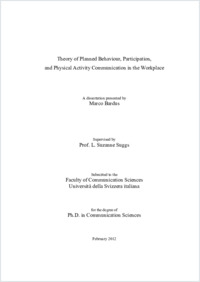Theory of planned behaviour, participation, and physical activity communication in the workplace
- Bardus, Marco
- Suggs, Suzanne (Degree supervisor)
-
26.04.2012
406 p.
Thèse de doctorat: Università della Svizzera italiana, 2012 (jury note: Magna cum laude)
Theory of planned behaviour
behaviour change
workplace
physical activity communication intervention
participation
English
Introduction: Promoting health and physical activity in the workplace is advocated by public health institutions across the globe. There is a need to find effective ways to understand the determinants of participation in physical activity in order to outline appropriate communication strategies to promote physical activity behaviour change in the workplace setting. E-mails and text messages show great potential to reach a captive audience at minimal costs, but little is known on their effects on physical activity behaviour. Moreover, few studies have investigated employees’ reasons for participating in workplace physical activity interventions. Aims: This dissertation had three main objectives. The first was to test the predictive utility of the Theory of Planned Behaviour (TPB) in the context of a theory-based workplace physical activity communication intervention (the MoveM8 programme) promoting participation in leisure-time (LTPA) and work-related physical activity (WPA) through e-mails and SMS text messages. The second objective was to test the effect of the MoveM8 programme on TPB constructs (i.e., attitudes towards the behaviour, subjective norms, perceived behavioural control and behavioural intention), and on behaviour. The third objective was to examine employees’ reasons for participating and not participating in the MoveM8 programme, in order to provide a deeper understanding of what motivates employees to sign up for a workplace physical activity promotion intervention. Methods: To fulfil these objectives, both quantitative and qualitative methods were used. The first two objectives were achieved through the use of quantitative data collected through pre- and post- intervention surveys. The third objective was pursued using the analysis of interviews and focus groups conducted with employees who participated and who did not participate in the MoveM8 programme. The first two aims were investigated using structural equation modelling (SEM) techniques. The third aim was investigated using thematic analysis. Results: Results from SEM analyses provided evidence to support the capability of the Theory of Planned Behaviour in identifying the social-cognitive determinants of physical activity and predicting behaviour (total physical activity and LTPA, but not WPA). Perceived behavioural control was the strongest predictor of behavioural intention across all models (β ≈ .75, p > .001). Intention significantly predicted LTPA (β = .32, p > .001) and total physical activity (β = .34, p > .001) at 12 weeks (Time 1) and 16 weeks (Time 2) after the start of the intervention. Data also showed some significant, albeit small, intervention effects on attitudes across behaviours, and a small significant effect on WPA at Time 1, associated with the use of e-mails instead of the combined use of e-mail and text messages. Qualitative thematic analysis of interviews and focus groups revealed that the major reasons for participating in the MoveM8 programme were related to personal motives (e.g., the need to better manage weight), and to perceived positive characteristics of the intervention itself (associated with a curiosity towards a novel technology-based intervention and to the use of reminders), and to the role of employer in endorsing and recommending the programme. The major reasons for non-participation were related to lack of time, feeling that the programme was not relevant to them, lack of confidence with technology, and lack of follow-up with the promotion of the intervention, which was related to a limited support by the employer. Conclusions: The Theory of Planned Behaviour is useful to predict physical activity behaviour among employees. Future studies should use this theory to design, assess, evaluate and predict physical activity behaviour and its socio-cognitive determinants. This study confirmed the important role of technology-based reminders, in particular e-mails, as cues to action for promoting and maintaining physical activity in the workplace. Participation in a technology- based workplace physical activity communication programme is influenced by aspects related to individual’s needs and motivations to become more active, characteristics of the programme itself, and organisational support. To maximise participation, future studies should stress the importance of perceived benefits, involve organisations and employees in the design and creation of programmes, and facilitate access to these programmes by providing tangible incentives and continuous support so that larger segments of the population are reached.
- Language
-
- English
- Classification
- Medicine
- License
-
License undefined
- Identifiers
-
- RERO DOC 29176
- URN urn:nbn:ch:rero-006-110804
- ARK ark:/12658/srd1318328
- Persistent URL
- https://n2t.net/ark:/12658/srd1318328
Statistics
Document views: 673
File downloads:
- Texte intégral: 689
